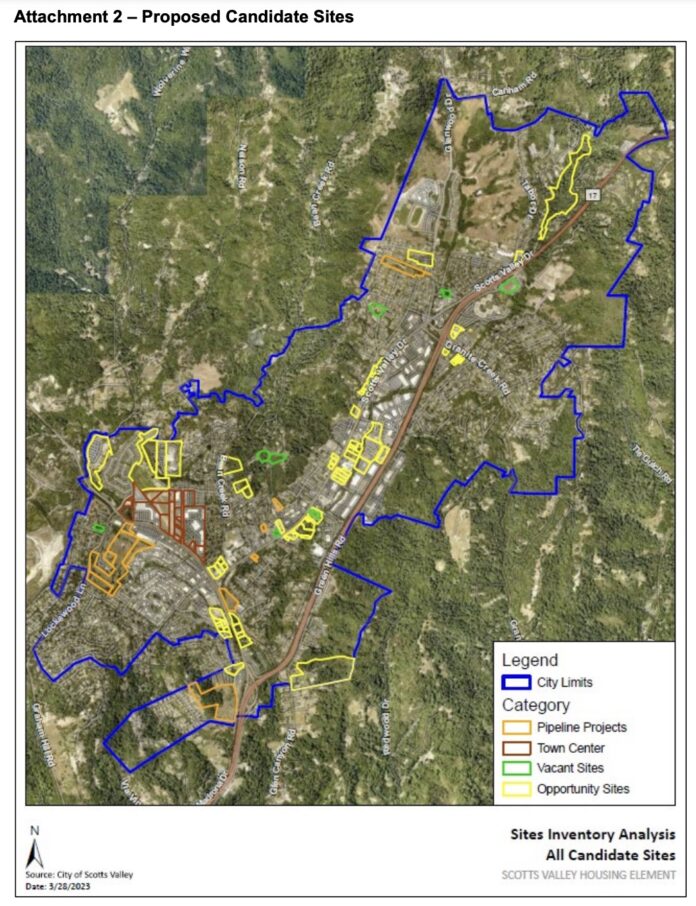
Scotts Valley has just over half-a-year to develop a Housing Element that other communities can take years to get across the finish line.
But it burst out of the starting gate April 5 with a joint Planning Commission/City Council study session that found the community could accommodate 279% more housing than the State of California is forcing it to prepare for.
Despite initial concerns from elected officials that it might be hard for the community to come up with a plan for 1,220 homes in the coming eight-year Regional Housing Needs Assessment cycle, Ines Galmiche, an urban planner at consultant Kimley-Horn, said their team had already identified places where as many as 3,407 units could go.
“These are sites that need to be near community resources and services, public transportation—as well as have access to utilities,” Galmiche said. “And these sites must all also ‘affirmatively further fair housing.’ This means that the City cannot allocate all of its lower-income units in the same area; they must be equitably spread out throughout the community.”
Scotts Valley has been assigned a minimum number of homes it must plan for in different income categories.
“For us to be able to allocate lower-income units on a site, the site must accommodate 20 dwelling units per acre,” Galmiche said, noting the planners found 369 units already in development can be counted toward the overall total. “We’ve identified a number of commercial sites, as well, that could accommodate either fully residential or mixed-use future developments, where we could account for just under 1,900 units.”
Currently the Town Center Specific Plan calls for 250 units, but that could be adjusted, Galmiche noted.
Industrial areas in Scotts Valley have the potential to be developed into 658 residential units, according to Galmiche, who added public and quasi-public land could account for as many as 1,000 units.
Bill Chapman, 59, who now lives in Davenport but owned a home and a business in Scotts Valley for decades, wasn’t at the meeting.
But, days later at JT’s Two Doors bar, as he poured over the map showing potential areas for residential development, he was a bit concerned—particularly with the old Watkins-Johnson industrial site that was so contaminated at one point it was placed on the Environmental Protection Agency’s Superfund Sites inventory.
“This is when the chemicals are so gnarly that the government had to pay to clean it up,” said Chapman, who owned a car repair shop in town. “We’re not talking about Roundup. We’re talking gnarly.”
The land is currently rated by the EPA as having a 28.9 rating on the Hazard Ranking System Score. The scale runs from 0 to 100; if a site scores 28.5 or more, it’s supposed to be placed on the National Priorities List.
Chapman thinks the defunct golf course would be a better place for housing.
Councilmember Derek Timm, however, wasn’t ready to write off the Watkins-Johnson site for residential use, though he doesn’t want Scotts Valley to have to deal with the chemicals that could still be lingering.
“I think if the EPA issue could be solved there, that should be considered,” he told the joint study session. “But that’s for the property owner to take on, not us.”
He said the storage facility behind Skypark would be a good option, but added he believes Scotts Valley shouldn’t cannibalize its ability to remain an industrial hub.
Multiple members of the public spoke to advocate for more housing.
One public commenter implored Scotts Valley to fight back against the State’s efforts to force it to build housing, the way many other jurisdictions have—though unsuccessfully.
Timm agreed that the community should “proceed under protest,” and he railed against the Association of Monterey Bay Area Governments process whereby Monterey County municipalities were able to foist more units on Scotts Valley at the last minute, he said. He even painted Huntington Beach’s ongoing legal battles with Sacramento on the subject of local control in a positive light.
Councilmember Randy Johnson remarked that supporters of a “Yes in My Backyard” mentality seem to be having a political moment, but noted that just because Scotts Valley is moving forward with new housing plans doesn’t mean the City is rolling over for developers.
In fact, this could be a moment to fix well-intentioned but broken policies, like a rule that requires 50% commercial for many lots along Scotts Valley Drive.
Multiple public commenters had suggested it doesn’t currently make sense to develop those parcels just to have them sit empty because of lack of interest from the businesses in occupying that real estate.
“Housing is going to have to be built,” Johnson said. “And it’s going to be uncomfortable, in some instances.”
He encouraged City officials to make strides toward solutions. After all, the State is being hard-nosed even when it comes to the timelines involved, he pointed out.
“We have to deal with this now,” he said. “I just think we’re on the right track here tonight.”












